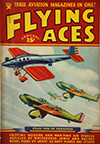“Flying Aces, January 1935″ by C.B. Mayshark
THIS May we are once again celebrating the genius that is C.B. Mayshark! Mayshark took over the covers duties on Flying Aces from Paul Bissell with the December 1934 issue and would continue to provide covers for the next year and a half until the June 1936 issue. While Bissell’s covers were frequently depictions of great moments in combat aviation from the Great War, Mayshark’s covers were often depictions of future aviation battles and planes—Case in point, for three issues, starting with the December 1934 issue, Mayshark depicted Air Battles of the future! For the January 1935 issue Mayshark gives us an Attack from the Stratosphere!
Air Battles of the Future: Attack from the Stratosphere
 DEATH and destruction from the skies! Raids on the United States mainland by an unknown
DEATH and destruction from the skies! Raids on the United States mainland by an unknown
foe!
Impossible? That’s what the armchair soldiers say. They see only attack in the form of surface vessels that may try to sneak through the natural defenses. A few with a broader scope of view admit that a few airplanes could take off from a carrier outside New York or Washington. But of course, they say, these planes would be stopped once they got inside the range area of the defensive microphones.
But there is a deadlier air weapon than the ordinary bomber or fighting plane. Let’s paint the picture.
Fifty thousand feet above the Gulf Coast, the sunshine is trickling through the clouds in straight lines, bringing life to the farmers and fishermen and merchants on the land and water below. But suddenly something else, mysterious and ominous, is trickling down through the clouds—in straight lines, also. Bombs! And instead of bringing life, they are bringing death and destruction to the people below.
With a shriek, they hurtle into view beneath the lowest strata of clouds, but no mortal force can stop them now. When these bombs hit, dirt, sunshine, and men alike are driven into oblivion, and hysteria and a ghostly fear follow in their deadly wake.
Frantic telephone calls stream out over the wires, and presently the C.O. at Maxwell Field, Montgomery, Alabama, is speaking. Are there any fast two-seaters available? Certainly! Several Curtiss Shrikes have just been sent down from Buffalo. Can they be prepared for action and flown to the coast immediately? Yes, immediately. That is all. Within five minutes three Shrikes rip into the air and head south, and on the grim faces of their pilots and observers is a look of courage and determination.
What are the machines that have been given this assignment?
The Shrikes are considered among the greatest attack ships in the world, and have provided a new design for many other countries to copy. The ship is manufactured by the Curtiss Aeroplane and Motor Company at Buffalo. It is a low-wing, wire-braced machine, carrying a pilot and an observer. The model shown on the cover is the Conqueror-powered job, listed as the A-8. The motor is chemically cooled, and rated at 600 horsepower.
Probably the most interesting feature of this ship is the armament, for it has been stated that it is equal in gun fire to a regiment of infantry. The observer is provided with two high-speed Browning guns. The pilot has the control buttons of four high-calibre guns in his cockpit. These weapons are hidden in the upper portion of the landing wheel cowlings, while in some models an additional high-calibre gun is mounted in the starboard wing root.
On actual attack work, the Shrike carries a special 500-lb. fragmentation bomb hung between the wheels. This is for offensive work against troops, ground activity and transportation.
Some one back at Maxwell has hinted that the attack is being made by a stratosphere machine of some sort. Every pilot is pondering on that statement. They circle over the area pin-pointed for them until they reach 25,000 feet, the ceiling of the new attack ships. They have taken to the oxygen masks 5,000 feet below this sky lane, and still catch no sight of the raider. Where—and what—is the menace from above?
The stratosphere ship which eludes the Army two-seaters so easily embodies principles of construction which are being employed at the present time in several countries.
There are two details of design in the stratosphere ship which might be alluded to as radical departures from conventional airplane construction. The first to note is the unusual depth to which the undercarriage is slung. The sole purpose of this is to allow an unobstructed radius for the long blades of the propeller when the ship is on the ground. The long-bladed air screw is used because a greater propeller beat is required in the thin air of the stratosphere.
The second feature to note is the comparatively large control surfaces, used because of the low resistance offered by the high-altitude atmosphere. The control surfaces of an ordinary airplane, if it could reach the stratosphere, would be of practically no avail.
The control cabin is absolutely air-tight, thus maintaining a pressure that is equivalent to that of sea level. Oxygen tanks are carried to insure a fresh supply of air at all times. The power plant is a twelve-cylinder, opposed, water-cooled engine, fitted with a super-charger. Difficulty is encountered in cooling an engine at high altitudes. Therefore, the radiators are located outside the metal hull.
The water radiator is on top, and is set in a longitudinal line so as to offer the least resistance. As water circulates through this radiator, it is cooled instantly upon contacting the extremely cold air to be found at great heights. The oil cooling is also accomplished by means of a radiator mounted outside the hull. Swung between the main struts of the undercarriage, this radiator is built so that the broadest surface is facing forward. Resistance offered is practically negligible, however, because of the small overall dimensions. All bombs are carried inside the hull, a trap being opened to emit them.
As the Shrikes speed along at 193 miles an hour to meet this monster, the Army pilots and observers scan the skies with searching eyes. If they must fight a stratosphere ship, they certainly cannot fight it in the stratosphere. With difficulty they can get a few thousand feet higher—but no more. Well, perhaps this strange demon of the air will eventually come down to get observations and pictures. Then they will have their chance.
The Shrikes continue along the coastline for perhaps twenty minutes in a westerly direction toward Mobile—and suddenly the stratosphere ship appears. Tearing down through the clouds at a terrific rate of speed, a long, blue low-wing monoplane seems about to crash into the Army two-seaters. With the speed of a darting snake, the leading Shrike banks to the right, and the observer fires the first shots. But to no avail!
The stratosphere ship has now pulled around and is beginning to climb, with the two-seaters frantically trying to reach it. Suddenly a gun tunnel is lowered from beneath the fuselage of the stratosphere ship, and as it belches tracer, the Shrikes are dispersed like leaves before an autumn wind. As they reassemble, they make one last desperate attempt to reach their adversary—but the height is too great.
What is the answer to this threat? Will it be an armored lighter-than-air ship, or will the anti-aircraft men develop a gun and range-finding equipment to stop it?
Our guess is that we shall have to fight fire with fire, and build stratosphere fighters.

Flying Aces, January 1935 by C.B. Mayshark
Air Battles of the Future: Attack from the Stratosphere




